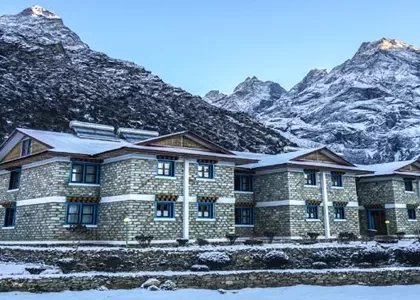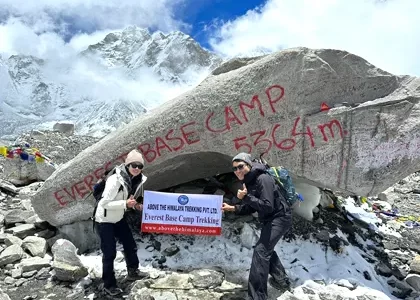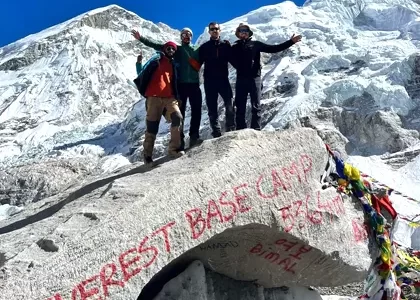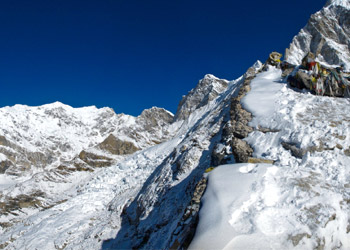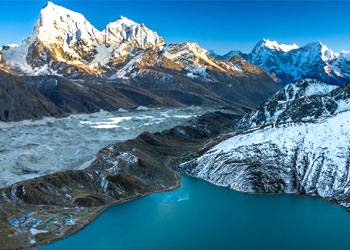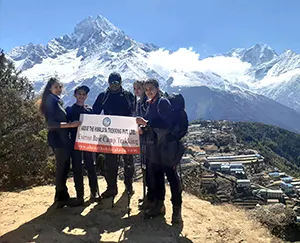Overview of Mount Everest Climbing
Mount Everest is the world’s highest peak, 8848 meters above sea level. Many travelers dream of walking on the foot of Everest, which is why hundreds of thousands of tourists come to Nepal to see it. The first Mount Everest Climbing by New Zealander Sir Edmund Hillary and Tenzing Norway of Nepal. They climbed it together on May 29. It is in the Mahalangur range of the great Himalayas of Nepal, which consists of four of the six highest peaks in the world.
Mount Everest Climbing in Nepal is a little expensive. According to the permit allowed by the Nepalese government, it costs USD 11,000 per climber. This peak is the best for mountain climbing in Nepal.
The weather condition of the Everest region changes fast and may be risky. The weather might change unexpectedly, although you had an excellent result from the forecast. Some things you should take include bottled oxygen and medicine for high altitude.
It would help if you also had down clothing, high-SPF sun cream, lip balm, sunglasses, gloves, etc. Other than that, you’d better pack some food and water, as the dining on Everest is very basic. You must bring cash, as the stores don’t accept credit cards during Mount Everest climbing.
Mount Everest Expedition
Mount Everest Climbing is a formidable challenge that requires meticulous planning, physical endurance, mental fortitude, and deep respect for the mountain’s unforgiving environment. The journey to summit Everest typically begins with months, if not years, of preparation and training. Climbers must be in peak physical condition, with a robust cardiovascular system, muscular strength, and endurance to withstand the rigors of high-altitude mountaineering.
Likewise, training often includes a combination of cardiovascular exercises, strength training, altitude simulation, and technical skill development. Expeditions to Everest are usually organized through licensed guiding companies or independent teams, each meticulously planning logistics, route selection, and safety protocols. The climbing season for Everest typically occurs in the spring and autumn, when weather conditions are more favorable, and the risk of avalanches and storms is reduced.
The two primary routes to the summit of Everest are the Southeast Ridge from Nepal and the North Ridge from Tibet. Similarly, the famous route is known for its challenging terrain, including the Khumbu Icefall, the Lhotse Face, and the Hillary Step. Reaching the summit of Everest is a moment of unparalleled achievement and triumph, but it is only half the journey.
Descending safely is equally challenging, as fatigue, altitude sickness, and adverse weather conditions pose ongoing risks. Despite the allure of Everest’s summit, the mountain exacts a toll on those who dare to climb it. Tragically, not all expeditions are successful, and Everest’s slopes are littered with the remnants of past attempts and lives lost to the mountain’s unforgiving embrace.
In conclusion, Mount Everest Climbing is a monumental undertaking that demands unwavering dedication, physical prowess, and mental resilience. It is a test of human endurance, courage, and determination, offering a rare opportunity to experience the awe-inspiring beauty and formidable challenges of the world’s highest peak.
Mount Everest climbing
Mount Everest is one of the main climbing destinations. Mount Everest Climbing has become the goal of many people around the world. The landscape and scenic beauty of this trek’s mountains are famous worldwide. You can get the best view of the mountains.
You can view Mt Lhotse (8,516m /27,940ft), Makalu (8,485m /27,838 ft.) & the giant Cho-Oyu (8,201m /26,906ft). Mount Everest is the highest mountain in the world, with an altitude of 8,848 sq. km. The Everest base camp lies at an altitude of 17,900 feet (5,500 m) from sea level.
Kala Patthar is the highest point of this trek, located at a height of (5,600m/18,373f). From here, you can get the best view of Mount Everest. We are discussing Mount Everest climbing costs here. Sagarmatha National Park also attracts many people. The national park protects and conserves lots of endangered Himalayan animals.
It has outstanding scenic beauty. The best thing about Mount Everest climbing is the diversity in culture and religion. Most people living around the Everest region belong to the Sherpa and Gurung communities. They follow Buddhism. Many small stupas and monasteries are on the route to Mount Everest climbing.
You can get the opportunity to observe the culture and traditions of people here. The Mount Everest climbing trail has rice paddies and alpine forests. The lush rhododendrons fill the route. The high-altitude terrains in the Khumbu range against the skyline are an absolute pleasure for the eye and heart. Mount Everest climbing cost is a challenging topic for travelers.
Mount Everest Climbing is no joke. You could be the best mountaineer in the world and still fear going on an expedition to the world’s highest peak. But, there are a few things to keep in mind if you have made up your mind to take the feat.
The Mount Everest Climbing is meant for those who are motivated to accomplish what many have not and could not. This does not only include your skills and expertise but also your mindset and willingness to achieve what has been considered impossible by many.
The following are all you need to know before you climb Mount Everest, otherwise known as Sagarmatha, in Nepal.
History And Evolution Of Mount Everest Climbing
Mount Everest was first climbed by Sir Edmund Hilary alongside his trekking companion Tenzing Norgay Sherpa in 1953. Hilary was part of the British Expedition Group. Furthermore, there are not many tales that suggest the actual history of Mount Everest climbing.
Most people from Nepal believe that mountain climbing may have had military origins. While there weren’t any mountaineers who would contribute to the community as much before the first Mount Everest ascent in Nepal, the military had always been a big part of Nepalese history.
During wartime and for adventurous purposes, the military men in the past possibly have climbed Mount Everest. But the possibility of this being true is just as high as it only being an assumption.
Mount Everest climbing started in 1953 and the expeditions have never stopped. There are hundreds of mountaineers and adventurers who travel to Nepal every year to climb the tallest mountain in the world.
There have been a fair amount of deaths in the mountain because of several circumstances. The losses of these mountaineers, however, have never proven to have aspiring trekkers and mountaineers to step back from their motives.
The peak is very high and has a good amount of challenges. But, besides the first climbers of the peak, there have been many who climbed the peak since.
Some of the notable climbers include Junko Tabei, who was the first woman to climb Mount Everest, Kami Rita Sherpa who became the first to climb 25 times, Babu chiri Sherpa, who climbed the peak in 16 hours, and Yuichiro Miura, who became the oldest to climb the mountain.
Despite the challenges, many mountaineers over the years have been able to climb it and come back safely. As of the current time, there are many facilities associated with climbing Mount Everest.
Unlike in the past, mountaineers don’t have to be as worried about their safety as there are more than just them and their guide who will be climbing the peak in a single expedition. The facilities in the base camp and several spots at the peak make it possible for the mountaineers to have a relaxed journey as well.
Moreover, trekkers nowadays have easy access to good facilities and trekking services from the most reliable agencies in Nepal. Such agencies are guided by local guides with years of experience which always helps them attain their goal of summiting the mountain without many issues.
Above the Himalaya has worked for several years to accommodate, guide, and fulfill trekking dreams among trekkers and mountaineers with the highest possible goals. We make dreams come true by giving you the best possible service and experience!
Preparation For Mount Everest Climbing
Summiteers must be very wise and thoughtful when they are preparing to climb Mount Everest. You cannot simply wake up one day and go on the expedition the next. Climbing Sagarmatha requires you to spend months and even a year of training.
If you are trained in mountain climbing, then it is possible that you will find it easy to reach the top of Mount Everest without much issue. But, if you are a beginner and simply are looking to climb the mountain to fulfill a lifetime goal, then hold yourself back.
While it requires one to have good expertise and knowledge of the ruthlessness and challenges in the mountains, anyone can climb Mount Everest with proper training and preparation as per necessity.
The following are some ways you can prepare for Mount Everest climbing to ensure success:
Physical Preparation
You have to become physically ready to get closer to your goals. No amount of training aside from physical training equals it. Physical preparation usually includes training muscles to build strength and flexibility, climbing conditioning, and cardiovascular training.
A trekker who aims to reach as high as possible on Mount Everest must train on a daily basis, and we mean every word. You cannot simply climb the mountain after having trained for a week or even a month before you go to the peak.
Though your goal may not be Mount Everest Climbingt, you still need enough physical endurance capacity to get through certain distances and trails ahead of you in the journey. The following are the most useful ways of training yourself physically:
A climber must condition his body to the different circumstances he will come through during the journey. Climbing conditioning refers to getting your body used to climbing both uphill and downhill by trekking on challenging trails.
Trekkers can best condition their bodies by climbing mountains that are at a smaller altitude and easier to climb than Mount Everest itself. You can use different equipment and gears that you may need during your expedition to Everest when you are training.
Besides going to the mountains or a trekking trail, you can also practice climbing with the help of stair machines. These machines must be used at least three times a week and you must continuously work in it for 30 minutes. A minute-long break can help you avoid leg cramps in the initial days of the practice.
- Lower Body Strength Training
Trekkers have to build their lower bodies to sustain the tough and rough conditions in the mountains. To train your lower body, you can go to the gym, jog, run, or simply walk a good distance every day for several weeks or months until you’re ready to go to Mount Everest.
Most trekkers tend to work out at home as well. You don’t have to work out every other day. Instead, you can use alternate days for workouts keeping the duration to 30 minutes for each exercise. Rest is very necessary.
Squats, lunges, sit-ups, deadlifts, glute bridges, etc. are best for lower body strength training. For your core, you can try planks, leg raises, Russian twists, and mountain climbers.
Another great way of training your body is by practicing cardiovascular exercises. These exercises refer to the ones that keep your body’s energy level balanced. Aerobics are the most common exercises for cardiovascular training.
Since this kind of exercise works not only for a specific part of the body but the entire body, it makes you fit and flexible. Some common cardiovascular exercises are swimming, cycling, and running.
While the exercises that we have mentioned above help you in building your flexibility, there are certain exercises that specialize in flexibility. These workouts or training practices increase mobility and help you prevent injuries.
If you want to keep your body protected from dangers and stay healthy and fit all around the journey, then flexibility training can best help. You need to train your body for flexibility at least three to four times a week.
Yoga, Tai chi, stretches including calf stretches, hamstring stretches, spinal stretches, hip flexor stretches, and quadriceps stretches are some of the best exercises for flexibility training.
Mental Preparation for Mount Everest climbing
Mountaineers or trekkers must also have sufficient mental resilience. Just training physically is not going to be enough. You really don’t want to be opting out at the end minute just because you are not able to prepare yourself.
Even if this is not always the case, some trekkers might have to go through a situation like this if they are not mentally prepared. Mental preparation is, if not more, just as important as physical preparation.
There are several ways you can prepare yourself mentally for the journey. Some helpful ways are as follows:
- Consult With Trekking Planner
You have to get in touch with an experienced trekking planner before you start your journey. Not consulting with a trained professional beforehand can lead to problems that you may not even have imagined.
An expert can do a lot to make your journey to Mount Everest successful. If you are trekking with amateurs or trekkers with little experience, then you might be in trouble. Planning a trek does not come easily to everyone and that’s common.
Trekking planners will help you discuss routes, and challenges, and set expectations for the journey in the minds of the trekkers or mountaineers. You also get to learn more about the location and the travel when you seek consultation.
- Set Realistic Expectations
What often leads to disappointment among trekkers is expectation. When your expectations are too high, you have no option but to weep before the journey even ends.
Setting realistic expectations makes it possible for you to fulfill them without much difficulty. It is possible that you won’t even have to go through all the mental burdens due to failure when you start realistically.
Any trekker who does not want to set realistic expectations should prepare themselves for failure. Hence, the best thing to do is to simply try and get help from an experienced mountaineer, trekker, or agency to tackle the difference between what’s realistic and attainable and what is not.
Becoming mindful and calm is essential when you are going to climb Mount Everest. Even if you are not summiting the peak, you need a good amount of patience to keep going.
Trekkers who are not patient will suffer heavily as they proceed in their journey. A sense of panic or anxiety can ruin your entire trek. In many cases, an impatient or overly anxious trekker tends to descend or discontinue their journey just because of their mental instability.
You need to remember that climbing Mount Everest is not child’s play. Everyone who is on the journey must be mindful and calm throughout the expedition. Meditation can be of great help in achieving mindfulness as necessary.
Mount Everest climbing is for those who are positive. You will be expediting in a group. Therefore, if you are not much of a group trekker, then you should prepare yourself for what is waiting for you.
Positivity can be a great source of success. The more positive you are, the more it will become possible for you to continue your journey with guaranteed success. An ounce of negativity can cause you to lose hope and become weaker.
When you keep your mind focused on the good side of every aspect that you come through or divert your mind from contrary negatives, you will become a winner in your journey to the tallest peak in the world.
When you are a trekker who does not want to seek help, you are pushing yourself into danger without knowing. Climbing Mount Everest is all about teamwork. When you work with your goal alongside everyone in your team, you will be more prone to success.
Seeking help should not be considered a sign of weakness. Anyone who seeks help during the journey is considered to be strong and have good skills as a mountaineer or a trekker.
Likewise, when you are open to seeking help, it becomes easier for you to cross even the toughest of trails and to calculate problems and challenges in a sounder manner.
Planning The Logistics
You need to manage the logistics alongside the trekking agency before you proceed with your journey. Last-minute packing and preparations are not going to be of help when you are going on a major journey like that of Mount Everest climbing.
Climbing the mountain can be immensely dangerous and the rules that you’ll have to follow may sometimes play a role in disturbing your journey’s flow. In order to keep your trek smooth and simple, you need to be very wise while planning the logistics.
Managing the permits required is very important. Since we will be handling the permits, you can worry less about it. The permit costs and requirements will be discussed before the expedition. All the trekkers who are flying from abroad must also have a tourist visa to secure themselves from legal hassles.
Travel insurance is included in our package. Henceforth, you don’t have to worry about the possibility of meeting an unforeseen situation. Other than the basics as mentioned before, you will have to collaborate and unite properly with the guides and other facilitators in the journey.
Since you won’t be provided with trekking gear and clothing, you will have to manage all of it by yourself. The trekking gears include torch lights, ropes, trekking poles, headlamps, etc. You can easily find the best quality gears in Thamel or Pokhara. Thamel in Kathmandu is the best place to buy the cheapest equipment and gear for climbing Everest.
As for the clothing and other essentials required for your helpers on the journey, we will cover it all. Oxygen cylinders and first aid boxes will also be managed by the agency. As for the food, you will get your breakfast, lunch, and dinner from teahouses and certain landmarks on the way. You may, however, want to carry snacks.
Trekkers should carry their drinks. You may want to carry a water bottle of at least one liter or more. This may seem like a small necessity but it is more than just a checklist.You need to stay hydrated throughout the journey and you cannot always borrow water from fellow trekkers. They will also need water as much as you.
Be safe by carrying water-purifying tablets as well. When you carry enough tablets, you can clean the water and drink them no matter where you are. Unsafe water can cause different illnesses along the way. Water safety ensures good health throughout the trek.
Learn About Acclimatization
An issue many beginner trekkers and climbers tend to face is that of not knowing the importance of acclimatization. You have to be well-versed in the importance of taking breaks along the way when you are climbing an altitude as high as Mount Everest.
Going to even only the Everest Base Camp can be risky if you don’t acclimate properly. Rest and acclimatization are vital in guaranteeing success for Everest climbers. There will be many landmarks where you will stop on your journey. These are the locations that will help you rest adequately before proceeding towards the next destination.
Acclimatization also helps trekkers in setting realistic goals. Therefore, you will be able to slow down during the process and enjoy the moment. Anyone who rushes on the journey through the mountain is likely to suffer.
Not acclimatizing can lead to failure, serious injuries, respiratory issues, and sometimes, though in rare cases, even death. On the other hand, when you practice acclimatization properly, you will save yourself from all such dangers.
Learn Technical Skills for your Mount Everest climbing
Physical preparation as mentioned above can help you become ready for the journey but gaining technical skills is very important too. Practicing technical skills does not come easily.
You will have to spend several days and hours in the months before your Everest climbing journey in the hills and mountains.
Not only this, but you also can go to rock climbing locations and practice climbing with guidance. All these outdoor activities will help you get the best technical skills. If not a mountain as high as Mount Everest, try going on expeditions to destinations above the altitude of 5000 meters.
How To Succeed In Mount Everest Climbing?
Climbing Mount Everest is not easy, but we are stating the obvious when we say this. There have been many who have tried to climb the mountain but had to return or discontinue their expedition.
When you often make mistakes in climbing, it is common to fall victim to the circumstances you create. But you also need to remember that not everything that happens in your journey should be blamed on you.
There are a good amount of risks and challenges but there are just as many precautions and steps you can follow to ensure success in climbing Mount Everest. The following are some ways you can do just that:
Become Known For Sickness And Risks In Growing Altitude
You should keep in mind that climbing Mount Everest is not going to be easy. You will have to go through several issues and troubles along the way which also include sicknesses and chances of fatalities.
If you are not cautious about the pace you take, the food you eat, the amount of water you drink, or acclimatization, then you might suffer from Acute Mountain Sickness (AMS), HAPE, and HACE. These illnesses are very common among mountaineers.
You need to rely on precautions more than on ways of curing these illnesses. Cures are often tougher and don’t always guarantee wellness and recovery either. Make sure to do a fair bit of research on all the sicknesses, how they can be prevented, and how you can ensure safety and good health in your journey.
Not all trekkers know this but descending on time is very important too. When you don’t feel good but have a feeling of reaching your goal regardless, don’t follow your heart in such situations. Keep in touch with your group members and your guide and descend whenever you feel a sense of discomfort either physically or intuitively.
Death Zone Can Be Lethal
Climbing Mount Everest does not necessarily mean that you will be reaching 8848m through the trails. It can simply mean that you will climb the mountain beyond a certain height, which usually extends higher from the Everest base camp.
If you don’t know already, you have to become familiar with the Death Zone on Mount Everest. The Death Zone refers to the height beyond 8000m in the mountain. Air gets thicker and it becomes difficult for a mountaineer to keep himself going beyond the Death Zone.
Mountaineers who want to remain safe and avoid any possible dangers can simply choose to not go a step beyond this zone. If you are an adventurer who wants to test yourself, then it is best to consult with a physician before the journey and your trekking operator before you proceed beyond this zone.
You should also not forget that many mountaineers have failed in their attempt to cross the Death Zone because of the difficulties and unforeseen situations that come their way. As we mentioned before, always keep your goals in Everest realistic!
Choose The Best Season And Avoid The Rest
At Above The Himalaya, we ensure the safety of our clients. Henceforth, we strictly suggest that all trekkers choose only the peak seasons to expedite Mount Everest. If you are going to the mountains in seasons that are least preferred, then you may be inviting danger your way.
Make a wise decision while you can. Trekking operators usually don’t work during the off-season due to the hardships and risks associated with them. Similarly, the chances of failure during the off-season are just as high.
The best seasons to climb Mount Everest would be spring and fall. Why should you choose these seasons? Simple.
The fllowing briefly explains why you should choose either of the two seasons:
Spring is the season when there is bloom and new freshness in the air for the Mount Everest climbing. After winter, the air will just have cleared and warmed up. You don’t have to spend too much time deciding on the right pair of clothes and shoes to wear on your journey, either.
Unlike summer and winter, basic trekking clothes and gear will be sufficient. And, finding good accommodation and amenities won’t be an issue. The view of the mountain and the mountain will also be worth your while.
Trekkers usually find it more convenient to take pictures when they are on Everest during springtime because there are no clouds and the lighting is usually perfect. The snow will also have melted impressively, which decreases the chances of avalanches and other such accidents in the peak.
Since faunas will also be out of their habitats, you will get a chance to know more and see the rare wildlife species along the way.
Move With The Crowd & Join a group for Mount Everest climbing in 2026/2027
Many mountaineers would want to move alone rather than move with the crowd to experience the adrenaline rush better. But when you are on Mount Everest, this might prove to be fatal. Don’t ever move without the crowd.
One of the best reasons why you need to trek in peak seasons is because you get to expedite with a crowd and are never left alone. When you do this, it becomes easier for you to accomplish your goals without putting yourself in the mouth of possible danger.
Your group will always be there to assist you if you fall into challenging situations. There is, likewise, a lesser chance for the trekkers to fail when they are in a crowd because they also stay motivated. When you walk with a team of fellow mountaineers, you can also avoid the risks of getting lost along the trails.to join the group date for your Mount Everest Climbing you can book our group join date for 2026
Remain Ethical And Respectful
Mountaineers must always remain ethical and respectful of the culture, traditions, and regulations of the Khumbu region. Cultural sensitivity and ethical practices can help you carry on with your journey successfully.
When you disregard languages, festivals, or people’s traditions, the locals might not like it. This may lead to unnecessary consequences as well. Be mindful of what you say and how you act all through your expedition to and from Mount Everest.
Practicing Eco-friendly regulations with sincerity also will help you enjoy your journey while avoiding uncalled-for problems. The authorities in the Khumbu region are quite strict with their rules as they are always seeking to protect and preserve their culture, ecological elements, etc.
Conclusion
Mount Everest Climbing is possible! You just have to follow the right methods and remain ethical. When you cooperate with your trekking group, then you will also find yourself merrily moving your way up and down the mountain without issue.
Mount Everest sure is at a height like no other mountain in the world, but you have to remember the power of strength, motivated heart, and good knowledge. Make sure to keep your mind away from negativity. That being said, don’t push yourself beyond your capabilities, but hold on to the possibilities!
 Enjoy Himalayan scenery with the help of Nepal’s best guides with Government license holders and got training in first-aid, our Trip Leaders, know where you’ll find the best photos, most fascinating wildlife, and the best stream crossings.
Enjoy Himalayan scenery with the help of Nepal’s best guides with Government license holders and got training in first-aid, our Trip Leaders, know where you’ll find the best photos, most fascinating wildlife, and the best stream crossings.

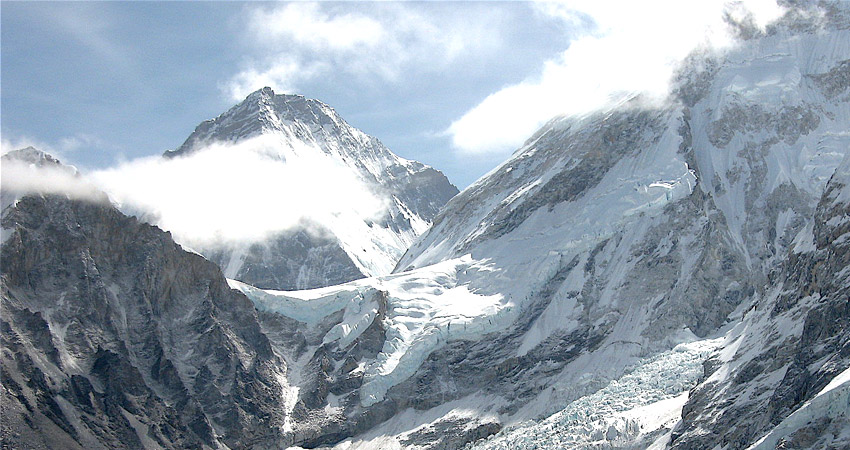





 Have Questions?
Have Questions?
